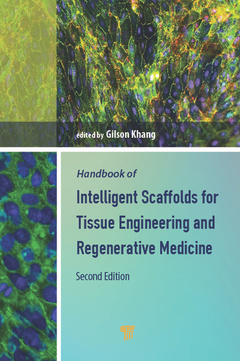Handbook of Intelligent Scaffolds for Tissue Engineering and Regenerative Medicine (2nd Ed.)
Coordonnateur : Khang Gilson

Millions of patients suffer from end-stage organ failure or tissue loss annually, and the only solution might be organ and/or tissue transplantation. To avoid poor biocompatibility?related problems and donor organ shortage, however, around 20 years ago a new, hybridized method combining cells and biomaterials was introduced as an alternative to whole-organ and tissue transplantation for diseased, failing, or malfunctioning organs?regenerative medicine and tissue engineering. This handbook focuses on all aspects of intelligent scaffolds, from basic science to industry to clinical applications. Its 10 parts, illustrated throughout with excellent figures, cover stem cell engineering research, drug delivery systems, nanomaterials and nanodevices, and novel and natural biomaterials. The book can be used by advanced undergraduate- and graduate-level students of stem cell and tissue engineering and researchers in macromolecular science, ceramics, metals for biomaterials, nanotechnology, chemistry, biology, and medicine, especially those interested in tissue engineering, stem cell engineering, and regenerative medicine.
Biomaterials and Manufacturing Methods for Scaffolds in Regenerative Medicine: Update 2015. Biomineralized Matrices as Intelligent Scaffolds for Bone Tissue Regeneration. Bioceramic and Composite Scaffolds in Drug Delivery and Bone Tissue Engineering. Recent Developments in Materials Innovation in Bone Tissue Regeneration. Carbonate Apatite Scaffolds for Regenerative Medicine. Mg-Based Biodegradable Metals for Scaffolds. Functional DNA Building Blocks and Their Hydrogel Scaffolds for Biomedical Applications. Recent Progress of Intelligent Hydrogels for Tissue Engineering. Polyanionic Hydrogels as Biomaterials for Tissue Engineering. Hyaluronic Acid–Based Hydrogel as a Scaffold for Tissue Engineering. Biologically Triggered Injectable Hydrogels as Intelligent Scaffolds. Cytocompatible and Reverse-Transformable Polymeric Hydrogel Matrices. "Smart" Hydrogels in Tissue Engineering and Regenerative Medicine Applications. Cell-Encapsulating Polymeric Microgels for Tissue Repair. Injection Materials for the Larynx. Bionanocrystals in Tissue Engineering Strategies: Tools for Reinforcement, Nanopatterning, and/or Nanostructuring of Polymeric Scaffolds and Hydrogels. Porous Scaffolds Using Dual Electrospinning for in situ Cardiovascular Tissue Engineering. Biofunctionalization of Electrospun Fibers for Tissue Engineering and Regenerative Medicine. Electrospun Fibrous Scaffolds. 3D Printing of Tissue/Organ Scaffolds for Regenerative Medicine. 3D Printing Technology Applied to Tissue Scaffolds. Nanomaterial-Assisted Tissue Engineering and Regenerative Medical Therapy. Application of Nanodevices in Sensing and Regenerative Medicine. Micro-/Nanotech-Based Craniofacial Tissue Engineering. Carbon Nanotubes: A Kind of Novel Biomaterials for Scaffolds of Tissue Engineering. Bacteriophage Scaffolds for Functional Assembly of Molecules and Nanomaterials. Intelligent Scaffold–Mediated Enhancement of the Viability and Functionality of Transplanted Pancreatic Islets to Cure Diabetes Mellitus. Extracellular Matrix–Derived Biomaterials: Molecularly Defined Ingredients and Processing Techniques. Biological-Derived Biomaterials for Stem Cell Culture and Differentiation. Demineralized Dentin Matrix (DDM) Scaffolds for Alveolar Bone Engineering. Biomimetic Scaffold Fabrication for Tissue Engineering. Scaffolds for Tracheal Regeneration. Bladder Tissue Engineering. Scaffold Applications for Vascular Tissue Engineering. Annulus Fibrosus Tissue Engineering: Achievements and Future Development. Corneal Endothelium Regeneration: Basic Concepts. High-Throughput Screening of Extracellular Matrix–Based Biomaterials. Effect of Scaffolds with Bone Growth Factors on New Bone Formation. Drugs as Novel Biomaterials for Scaffolds. Biocompatible Surface Coatings for Silicone-Based Implants. Synthetic/PLGA Hybrid Scaffold for Tissue Regeneration: Update 2015. Biomedical Applications of Silk Fibroin. Tissue Fabrication and Regeneration by Cell Sheet Technology. Stem Cell Engineering Using Bioactive Molecules for Bone-Regenerative Medicine.
Gilson Khang is a professor at the Department of PolymerNano Science and Technology, Chonbuk National University (Korea) and a visiting professor at Tsinghua University, Peking University, and Zhejiang University (China) and the Wake Forest Institute of Regenerative Medicine (USA). Dr. Khang was elected as the founding Fellow of Tissue Engineering and Regenerative Medicine (FTERM) in 2012. He is a member of the Tissue Engineering and Regenerative Medicine International Society (TERMIS) and a founding member of the TERMIS-AP chapter, of which he is also the continental chair since 2015. He is also an executive board member of TERMIS Global and since 2016 the TERMIS Global president-elect. From 2004 to 2009, Dr. Khang was editor-in-chief of Journal of Tissue Engineering and Regenerative Medicine. He has also served as co-editor-in-chief of International Journal of Tissue Regeneration, in addition to being on the editorial board of many reputed scientific journals. He has co-authored/edited 10 books and published around 550 original research papers and 200 editorials, reviews, and book chapters. His major scientific contribution has been to the analysis of natural/synthetic hybrid scaffolds to reduce host inflammation reactions, as well as the commercialization of tissue-engineered cartilage, bone, retinal pigment epithelium, and corneal endothelium.
Date de parution : 06-2017
15.2x22.9 cm



